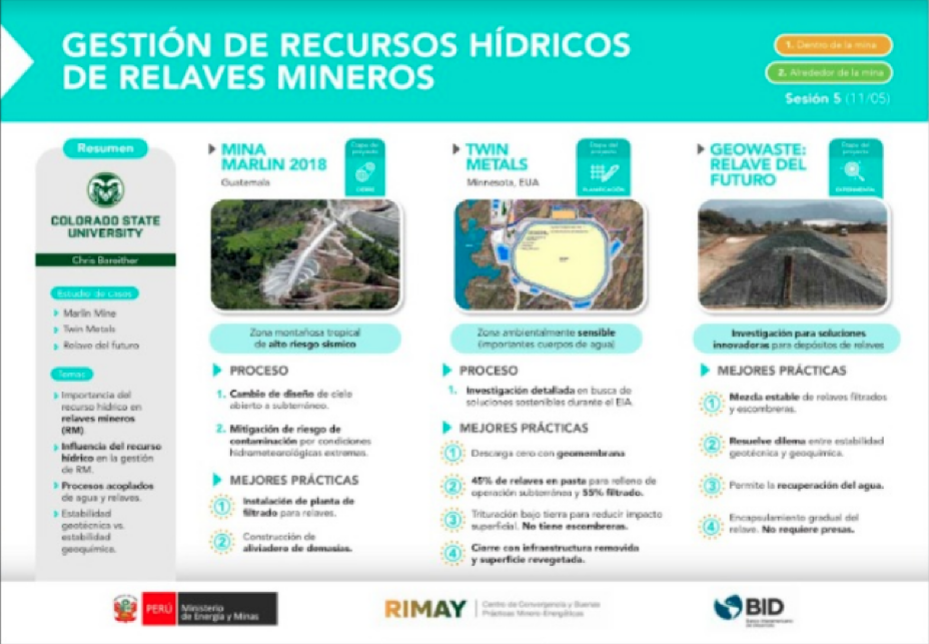PERUMIN HUB MINING INNOVATION IN PERU


CHALLENGESENVIRONMENT & SUSTAINABILITY
The main challenge in expanding the mining activity lies in the level of sustainability that can be achieved. This is essentially based on the efficient use of natural resources, as well as their environmental footprint.
As a result of the absence of environmental awareness and regulations, the Peru from the past has left us with more than 8,000 mining environmental liabilities (mostly without identifiable responsible parties), of which only about 1,000 are in the process of remediation.
How to reduce, treat, take advantage of and/or improve the disposal, use and reuse of tailings and/or waste rock dumps and/or environmental liabilities?
Tailings are the main waste to be managed due to their high toxicity and large volumes, generating a perception of high negative impact when stored. Likewise, mine waste is the sterile material or low-grade mineral obtained as a result of the work done to obtain the mineral. In both cases, a system of permanent evaluation of associated risks is required.
Environmental liabilities are those facilities, effluents, emissions, remains or waste deposits produced by abandoned or inactive mining operations, which constitute a permanent and potential risk to the health of the population, the surrounding ecosystem and property (Law 28271, Law that regulates the environmental liabilities of mining activity). These liabilities are grouped in about 751 ex-Mining Units (exUM). However, for the time being there is no update of their specific characteristics nor a realistic estimate of the resources needed for their remediation (IDB, 2021).
Mining companies and allies are looking for technologies that consider one or more value elements in their proposal.
Elements of value
Solutions aligned to international standards such as the Global Industry Standard on Tailings Management (GISTM), among others.
Regarding tailings disposal, solutions that ensure the capacity of tailings dams, as well as their safety, with a focus on the structure. There is an opportunity for improvement in the incorporation of guidelines.
Promote a change in the unfavorable perception of tailings for alternative and safe uses.
Solutions with a circular economy approach: i) revaluation (profitable businesses that allow recovering the economic value) and ii) zero waste (maximum use of the concentrate).
Opportunity to consider in the proposed solutions, State tools such as Tax Liabilities.
Be clear about the advantages and disadvantages of the proposed use or reuse, considering, among others, its chemical stability (immobilization of contained metals).

How to implement technologies in operations to become a carbon neutral activity?
Mining is a key sector in the global agenda for sustainable development and climate change; but not only through its role as a supplier of minerals and metals, so necessary for the generation of clean technologies; but also as an agent of change capable of incorporating new technologies that reduce the carbon footprint and/or generate positive footprint allowing to be a carbon neutral activity.
Some energy alternatives that are being worked on are wind energy, solar energy, and biodiesel; likewise, green hydrogen is postulated as one of the pillars in the energy transition. However, carbon footprint reduction alternatives with economic/technical feasibility are still required.
Mining companies and allies are looking for technologies that consider one or more value elements in their proposal.
Elements of value
Technologies that not only reduce the footprint, but are cost-efficient (considering energy storage, access to the mine site, as well as environmental conditions).
Long-term approach including alternative uses of rehabilitated areas and considering a reduction of energy costs in post-closure activities.
Solutions that consider the value chain (focus on suppliers).
Consider in the solution continuous improvement processes for proper energy management and carbon footprint reduction such as those linked to ISO 50001.
Efficient measurement or quantification of the carbon footprint as a key element to measure improvement and generate a positive impact on the sector's reputation.
Synergy with other sectors or projects (e.g. reforestation, reducing the impact of illegal mining).

How to incorporate into mine closure technologies that facilitate efficiency in mine closure processes?
Mining activity is not perennial, but has a life time; this requires mining companies to establish a plan so that, once the activity is over, the conditions are equal or better than the conditions prior to it. Thus, mine closure can be defined as the set of activities to be implemented throughout the life cycle of the mine in order to meet specific environmental criteria and achieve the desired social objectives after the mining stage. Mine closure is a progressive process that starts at the earliest stage of the project with the conceptual design and ends only when the specific closure objectives have been permanently achieved. There are four scenarios: (i) temporary closure, where a detailed care and maintenance plan needs to be developed, considering the possibility of future operations at the site; (ii) progressive closure, occurs concurrently with the operation stage of a mine, when a component or part of a component of the mining activity is no longer useful and activities such as dismantling, demolition, landform restoration, and/or revegetation are required; iii) final closure, when as a result of the exhaustion of economic mineral resources, mining and processing operations cease, requiring activities such as dismantling, demolition, in-situ studies for final disposal and/or salvage of materials, physical, geochemical and hydrological stabilization, landform restoration, revegetation, among others; and iv) post-closure, where the owner is responsible for the care and maintenance of the site for a minimum period of five years after site closure (MINEM, 2006).
Mining companies and partners are looking for technologies that consider one or more value elements in their proposal.
Elements of value
Knowledge is still lacking for effective closures that allow future use and/or recovery of habitats based on metallurgical research.
Technologies that help the total recovery of the areas used during the operation, ensuring the sustainability of closure activities over time.
Technologies and/or solutions that incorporate the valorization of open pit closure costs, as well as acid water management.
Cost-efficient technologies in the various activities required according to the type of closure.
Solutions that consider the visual impact.
Cover technologies for closure of mining components.
Technologies/solutions that deepen the water-soil relationship for closure.

How to incorporate models that generate shared value in mine closure?
Mining works, at the end, must restore the environment almost as it was previously. The recovery of vegetation and/or geochemical stabilization in tailings deposit areas is slow and, in turn, there is a high dependence of the communities around the mine on the success of closure.
In addition to the environmental and reclamation approach, today it is unthinkable not to include adding value to the community in the closure strategy. Prior to the removal of facilities, it is necessary to verify whether the community will need some of them. It is necessary to think of the best uses for these facilities to generate new activities. It is no longer possible to think of closure at the end of the life cycle of the operation, but rather closure plans must be associated with the life of mine (LOM) and be progressive, so the data generation tools implemented must allow projecting the influence of mine closure on the environment and consider the long term.
Mining companies, State actors seek models/mechanisms and/or systems that consider one or more elements of value in their proposal.
Elements of value
Community involvement (communal companies / local actors) in land use planning, as well as in the generation of business models.
Digitalization of water: information technologies that value open data in a transparent manner with a focus on generating trust.
Solutions that consider visual impact.
Solutions for temporary/progressive/end/post-closure.
Solutions that promote the development of economic activities such as tourism, or others.
Solutions that consider the impacts that already closed mines are having.
Opportunity to adopt experiences from other countries considering the specific context of the ecosystem (climate: abundant rainfall, moorlands, etc.).
Nature-based solutions, as well as revaluation of ancestral solutions such as wetlands, among others.

How to generate shared value through the inclusion of economic, social, environmental and/or information and knowledge infrastructure?
Infrastructure is a key element for development, essential for improving people's quality of life, as well as for facilitating their inclusion in societies. Although a definition linked to tangible or capital goods is often used, in a broad sense infrastructure can be defined as the physical and organizational structures, networks or systems necessary for the proper functioning of a society and its economy.
The incorporation of economic, social, environmental and/or information and knowledge infrastructure generates an opportunity for inclusion for communities (sometimes located in remote areas), as well as strengthening the community-mining company relationship through the generation of shared value.
Mining companies and State actors seek models/mechanisms and/or systems that consider one or more elements of value in their proposal.
Elements of value
Infrastructure that facilitates the digital inclusion of communities and the impact this has on health, education, among others.
Solutions to meet the demand for transportation of minerals and people, considering the existing overload in the existing road infrastructure.
Future workforce.
Development of the local value chain.
Territorial approach.
Digitization of water: information technologies that value open information (open data) in a transparent form with a focus on the generation of trust.









